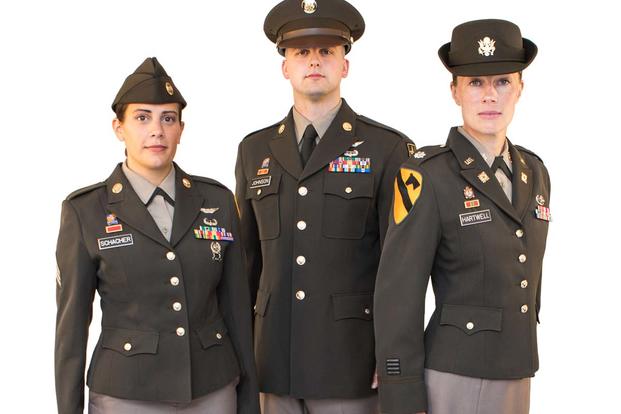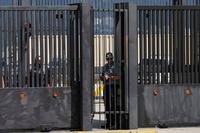The U.S. Army's top enlisted man is close to unveiling the final version of the World War II-era Pinks and Greens uniform that could be approved for all soldiers next year.
Sergeant Major of the Army Daniel Dailey and Chief of Staff Gen. Mark Milley began considering the possibility of bringing back the iconic two-tone uniform of the "greatest generation" for soldiers to wear as an everyday office uniform earlier this year.
"We wanted a uniform that we could re-identify with the American public that was significant in the American public's eye of the sense of pride in their Army," Dailey said.
"That's why we went back in history and said, 'What was the last time when there was this sense of pride and true identification … based upon their uniform?' And that's when automatically we both agreed it was Pinks and Greens during World War II.
"It was a very symbolic statement in America when you saw these young men and women coming back to and from war ... wearing that very distinctive olive drab jacket with pinkish hue pants uniform."
The first round of prototypes, unveiled at the Association of the United States Army's annual meeting in October, featured different versions of jackets and trousers as well as shoes.
Dailey said the Army will most likely have the final prototypes in early December. The uniform will feature a belted jacket, khaki shirt and brown leather shoes for men and women.
The next prototype "that you see will be very, very historically accurate" to the uniform Gen. George C. Marshall wore as the chief of staff of the Army during WWII, Dailey said.
During World War II, "there were several different versions, so to say you are completely historically accurate is very difficult to do," he said. "So what we have done is we have looked at a bunch of those different versions -- live and through photographs -- and we took what we thought to be the most historically correct.
"So if you look at General Marshall's pictures -- that is probably where it is headed now," Dailey said.
If the Army does approve the new Pinks and Greens, this will be the second major dress uniform in less than a decade.
The service replaced its dress green uniform after 61 years of service in 2014 with a version of the Army dress blue uniform -- the Army Service Uniform.
"We got rid of the dress greens, and we went to the dress blues or Army Service Uniform," Dailey said. "It was a great decision by the leadership at that time; I fully supported it."
The ASU is a "phenomenal uniform which dates back to the origins of the United States Army," but it may be too formal of a uniform for everyday office wear, he said.
The blue uniform was always optional for formal occasions when the Army had the dress greens, and that would be the intent for the future if the service adopts the Pinks and Greens, Dailey said.
"We are very cautious of the fact that we change uniforms; we are very cautious of the fact that this cost taxpayers dollars and that is why we are being very deliberate on communicating this to the American public, to soldiers, to Congress and asking everybody -- is this the right thing to do?" he said.
Another difference in the final version of the Pinks and Greens will be the jacket length for female soldiers. The first prototypes were designed from ideas from a "female board of soldiers" and included both short and long jacket lengths, Dailey said.
The prototypes in December will feature a medium-length jacket, he said. Female soldiers also preferred a necktie to a neck tab.
The black beret will remain, but there will also be a service cap and a garrison cap featuring "rounded edges, so it will not look like the pointed edges that were on the old dress greens garrison cap," Dailey said.
The brim on the service cap will be brown leather to match the shoes, he said.
"All this is pre-decisional," Dailey said, but the Army is also looking at making the iconic, short jacket, known as the "Ike Jacket," available for soldiers to purchase as an alternate uniform item.
In addition, there is also talk of an optional brown leather bomber jacket from WWII,"which soldiers love," he said.
The basic issue items will be the pants, jacket, shirt, socks, shoes and the hat, Dailey said.
The next step will be to take the new versions of the uniforms to Capitol Hill and show them to Congress to get lawmakers' feedback and discuss costs associated with the effort, he said.
More surveys will be sent out to get feedback from the force and, if all goes well, the Pinks and Greens will go to Milley for a decision sometime next spring, Dailey said.
"As I travel around, I get a whole bunch of emails and letters from retirees that still have their grandfather's uniform from WWII," he said. "The one thing they criticize me on, because they saw the prototypes, is the historical correctness, which we are going to fix.
"The biggest feedback that we got was it's got to be right," he added.
Dailey said the cost of the new uniform could be slightly higher than for the ASU but was not sure.
If there is a cost difference, the Army will make an adjustment in enlisted soldiers' annual clothing allowance to compensate for it, he said.
Dailey stressed he is very aware of the importance of maintaining tradition, and that is why "we have never strayed away from the core uniform of the dress blues; that was always the dress uniform."
"Timing is never going to be right on anything, but that doesn't mean you don't do the right thing," he said.
"I think this is the time that we have to say, 'OK, we understand that we made [a] decision in the past. Let's take a look at this uniform and, if it's what the American people and soldiers want, I think the benefit of that outweighs the risk us changing a uniform again,' " Dailey said.
-- Matthew Cox can be reached at matthew.cox@military.com.




























